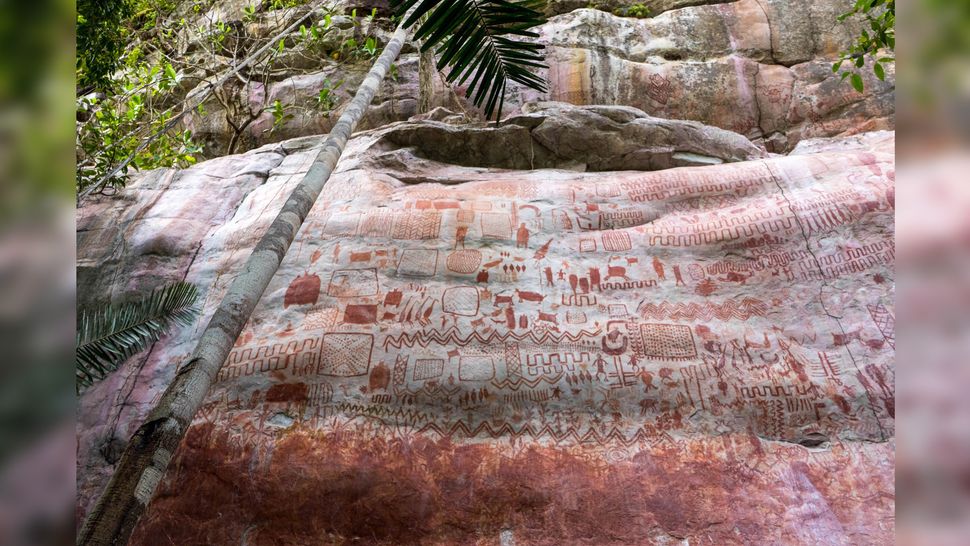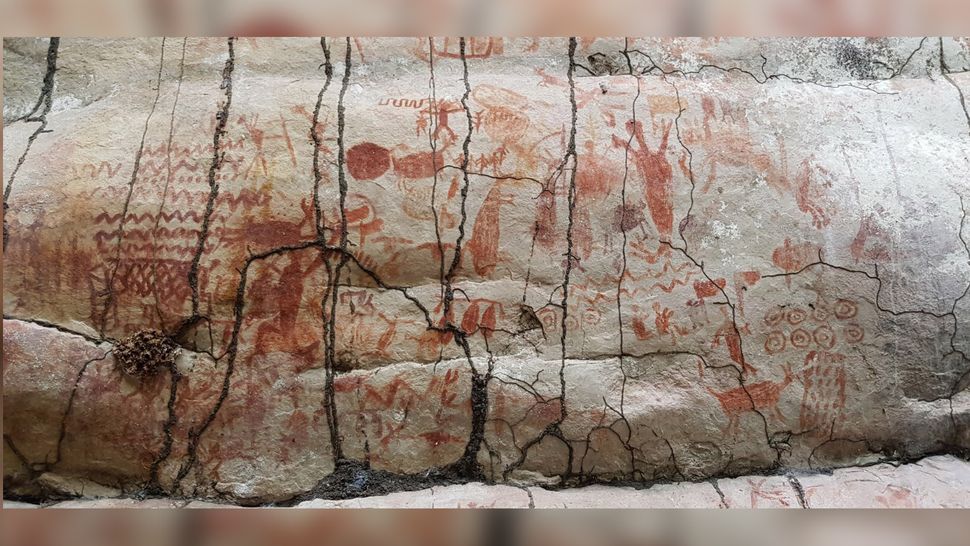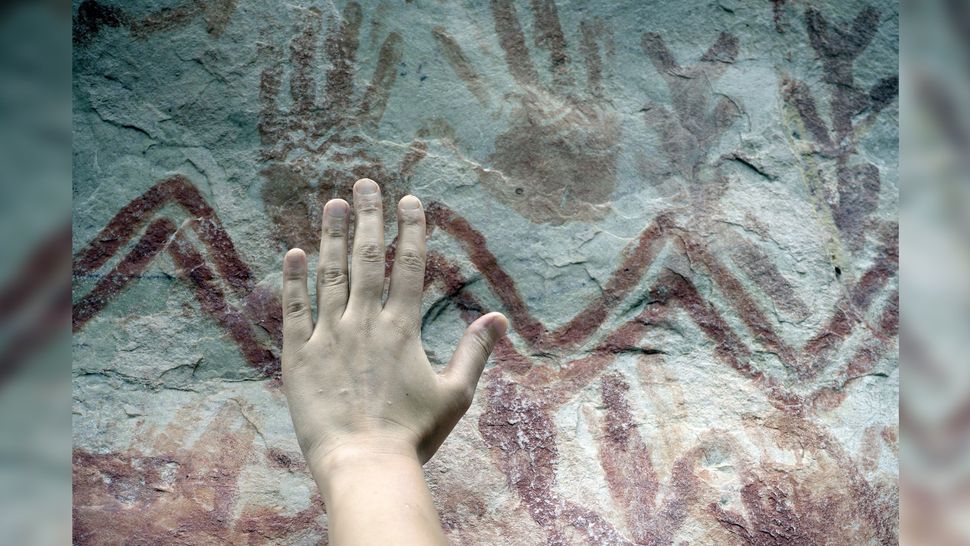Artists
Related: About this forumPrehistoric Rock Art discovered in the Amazon
https://www.theguardian.com/science/2020/nov/29/sistine-chapel-of-the-ancients-rock-art-discovered-in-remote-amazon-forestOne of the world’s largest collections of prehistoric rock art has been discovered in the Amazonian rainforest.
The discovery was made last year, but has been kept secret until now as it was filmed for a major Channel 4 series to be screened in December: Jungle Mystery: Lost Kingdoms of the Amazon.
The site is in the Serranía de la Lindosa where, along with the Chiribiquete national park, other rock art had been found. The documentary’s presenter, Ella Al-Shamahi, an archaeologist and explorer, told the Observer: “The new site is so new, they haven’t even given it a name yet.”
Jungle Mystery: Lost Kingdoms of the Amazon," which will air in the U.K. on December 5.



lunatica
(53,410 posts)Art is an innate and intuitive process of the human brain which we’ve had as a species from the beginning. It is NOT a fun pastime that people indulge in for superficial or puerile reasons. It is NOT a hobby.
Art is profoundly ingrained in our very being. In prehistoric times art was that indescribable mental ability to express the abstract through symbolic representation. In my opinion it still is. It’s a function wherein individuals communicated the ability to think, analyze, aspire, teach, understand concepts, and name themselves, animals, and the world around them. It is also the drive to make sense out of chaos, to understand and have dominion over other life forms and our own lives.
Art is profoundly linked to the human subconscious and intuition. Art is what, in actuality, makes us human. Without art there would be no imagination, no drive to communicate, no understanding of nature, no sense of time past or future. The hand prints tell the story of the concept of “I”, “us”, and “them”.
It’s unfortunate that art has been rendered unimportant, a hobby, something only the Masters do, or relegated to unimportant indulgence unless it meets some artificial societal measurement.
Everybody has art in their DNA. Creativity is us.
Beringia
(4,574 posts)I agree it is more than a hobby and I think everyone should be encouraged to do it, not just if you have "talent". I had the idea once that to say only the extremely gifted and talented people should pursue art, is like saying only professional basketball players or baseball players should play baseball.
lunatica
(53,410 posts)It is human creativity that feeds our souls and it’s dismissed by being diminished. All you have to do is look around and everything you see has been created by the art in our DNA. Architecture, cars, clothes, trains, bridges, movies. Oh! And music! And we just move and live in all these created products like it’s nothing much.
wnylib
(24,405 posts)art is like a written language. The more stylized it gets, the more it represents writing. And then the written symbols get arranged and rearranged into words, phrases, and whole stories, expressing even more creativity from the originally creative art expression. Poetry, with its images and ability to evoke feelings and thoughts, is painting with words.
The visual forms of all these expressions begin with painting visual images on rocks.
lunatica
(53,410 posts)I wish art was treated with the importance it has. You’re right about how it’s the foundation of communication.
JohnnyRingo
(19,315 posts)...I have to do it over every few years.
Beaten by equitorial the sun and pelted by torrential rains, I don't know how this dye has survived so long out in a rain forest climate.
Demovictory9
(33,758 posts)wnylib
(24,405 posts)JohnnyRingo
(19,315 posts)Just kidding, but that would be some headline.
wnylib
(24,405 posts)denbot
(9,912 posts)The Hopi say that their ancestors traveled to the farthest reaches of the four sacred cardinal directions.
![]()
marybourg
(13,182 posts)Star-Thrower
(309 posts)I love this stuff. I visited the ruins in Palenque and was awed by the stuctures. The Howler monkeys were not seen but heard, very haunting. I would love to go to Cambodia to see Angkor Wat, an item on my bucket list that will never be checked off. Unless I win a lottery, lol.
cab67
(3,219 posts)I have several colleagues in South America who have worked with rock art like this. They caution that animal depictions are often stylized and intended to convey messages beyond just what the animals looked like.
In other words, it's not at all clear that now-extinct large animals are actually depicted in any of this art.
This doesn't diminish the value of this discovery, but without knowing the intent of the artists, multiple interpretations are possible.
Beringia
(4,574 posts)wnylib
(24,405 posts)are stylized or literal representations of actual animals depends, too, on how specifically detailed they are. If they depict one or two specific traits of a real animal that once existed, it could be coincidence that a painted, stylized animal also looks like a real one that once existed. But if that happens with more than one species that just happen to all have lived in the same time period before becoming extinct, then it would be more than just coincidence.
cab67
(3,219 posts)There were also comparatively few such animals at the time of human contact that didn't somehow resemble something that's still around. That leaves the identifications open to modern interpretation. Were the artists drawing a litoptern, or was it a vicuna? Ground sloth, or tree sloth? Toxodont, or capybara? These drawings aren't nearly as precise as some of the cave art in Europe or rock art in northern Africa.
(That's not a criticism, by the way. Impressionist paintings aren't as precise as one of those Thomas Kinkade abominations, but they're still better in every way that matters.)
wnylib
(24,405 posts)It quotes Jose Iriarte, professor of archaeology at Exeter and expert on the Amazon and pre-Columbian history:
"The pictures are so natural and so well made that we have few doubts that you're looking at a horse, for example. The ice age horse had a wild, heavy face. It's so detailed, we can even see the horse hair."
That would be a hippidion, I believe, which went extinct in the Americas about 12,000 years ago. The article also mentions the giant sloth, paleollama, and ancient plant life, before the region was a rainforest. It also says there are tens of thousands of paintings, over a distance of 8 miles, that will take "generations" to study.
I'm inclined to accept their expertise.
cab67
(3,219 posts)But the professioanal archaeologists I know in South America disagree with Dr. Iriarte.
I'm inclined to accept their expertise.
(I'm a professional vertebrate paleontologist myself, for what it's worth. I don't do mammals, but I've done some work in South America and have a pretty good grasp of what was there. Still, I'm not an expert on South American indigenous art, so my opinion isn't worth a whole lot without the input of the actual experts I know.)
LudwigPastorius
(10,805 posts)Thought it was about someone at one of Bezos' warehouses finding an early, lost Yes album.
Beringia
(4,574 posts)genxlib
(5,691 posts)bluescribbler
(2,257 posts)Be it painting, sculpture, architecture or poetry, it is through their art that we know that ancient civilizations actually existed. Music, of course, is more problematic since it exists within time in a way the other arts do not. The fact that our current "civilization" seems not to care about the arts beyond the popular and the commercial is an indictment of our society.
Marcuse
(8,008 posts)The article infers that the 12,500 year estimate was not based solely on the images. When I went back to check the paywall came down.